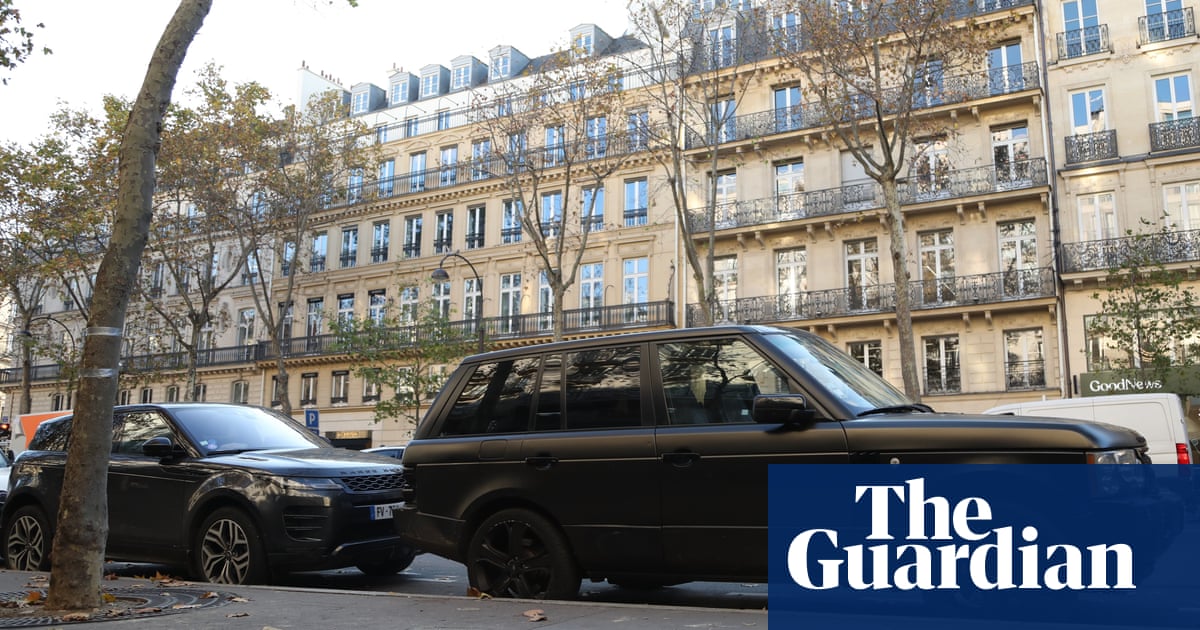New cars in the EU and UK have grown 1cm wider every two years, the Guardian can reveal, driven by large luxury SUVs whose sales show no sign of slowing.
“It’s unrelenting,” said James Nix, an analyst at the Transport and Environment (T&E) campaign group and author of the report. “Spurred on by sales of the largest SUVs, vehicles are getting wider every year.”
New cars have become so bloated that half of them are too wide to fit in parking spaces designed to the minimum on-street standards in many countries, the report found. The average width of a new car in the EU and UK passed 180cm in the first half of 2023, having grown an average of 0.5cm each year since 2001.
“That may not sound like a huge figure,” said Nix. “But the reality is that – unless there is reform – a cohort of large luxury SUVs and pickups will become as wide as trucks and buses.”
Big cars are more likely than small cars to kill people in crashes because they weigh more and have tall front ends that trap victims beneath them instead of knocking them to the side. They also pump more toxic gas into the air and eat up more space on roads and pavements.
For some cars that were originally designed decades ago, the need to incorporate safety features like airbags and crumple zones are part of the reason that newer models have grown bigger. But the recent trend is driven by consumers buying far larger cars that make roads more dangerous.
In the mid-1990s, the EU banned vehicles wider than 2.55 metres to stop trucks and buses from growing too large. But the legislation did not create separate limits for cars, which analysts say have started to cross key thresholds for which roads and cities were not designed.
Ahead of a planned revision of EU vehicle rules, campaigners have called on lawmakers to support a clause that would make the European Commission review the width limit. They argue that the trend towards bigger cars has reduced the space for other road users and increased the danger.
Crash data from Belgium from 2017 to 2021 shows that a 10cm increase in the height of vehicle fronts raises the risk of death by 30% when a car hits a pedestrian or cyclist, according to a study by the Vias Institute, previously the Belgian Institute for Road Safety.
Nix, who is based in Brussels and has two young children, said: “I have three- and five-year-old kids and we’re all about encouraging them to cycle. But I – as a man in my mid-40s – am becoming ever more intimidated by particularly large oncoming vehicles in streets in Brussels.”
The growth in car size also causes issues for their drivers. The report found that large luxury SUVs, which are around 2 metres wide, no longer fit in off-street parking. They also leave too little space for passengers to get in and out of vehicles in typical off-street spaces, which are around 2.4 metres wide, the report found.
Giulio Mattioli, a transport researcher at Technical University Dortmund, said: “Too much urban space is allocated to cars in cities – including free parking at the taxpayers’ expense for which little justification exists.”
Even in trailblazing capitals such as Paris and Barcelona, which have fought hard to reclaim roads for people to walk, bike and relax, more than half of street space is reserved for cars. On top of that, said Mattioli, cars in many cities are sometimes parked illegally, with little enforcement of parking rules.
“The fact that cars are getting bigger is likely to make the situation even worse,” said Mattioli. “It could also lead policymakers and planners to increase the standard measures of parking spaces, which could result in a vicious circle of ever-increasing size of cars.”
Paris may become the first big European capital to tackle this trend next month when it holds a referendum on higher parking charges for heavier cars. A similar scheme is set to start in Lyon in the coming months.
France has fought the trend towards heavier cars more than most of Europe’s big economies. Since 2008, it has provided a financial bonus to people buying a cleaner car and a malus, or penalty, to people buying a dirtier one. In 2022, the government extended the system to apply penalties that cover the weight of a car.
“That’s definitely one way to go because it could be budget-neutral,” said Gracia Brückmann, a transport policy researcher at the University of Bern. “[That] makes it easier to sell it to the public or taxpayer.”







